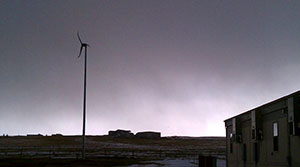Wind for Schools Project Funding Case Studies, Part 2: Cherry Valley Elementary School, Colorado
Sept. 9, 2013

Supplemental Environmental Project monies funded the turbine installation at Cherry Valley Elementary School in Franktown, Colorado. Photo from Colorado Wind for Schools, NREL 27000
The Wind for Schools project is part of the U.S. Department of Energy's (DOE's) Wind Powering America initiative. Since 2005, DOE provided funding for Wind Applications Centers in 11 Wind for Schools states, introducing teachers, students, and communities to wind energy applications and benefits. This Wind for Schools funding supported the project; it was not used to purchase turbines and equipment. Individual school champions emerged to find local funding mechanisms to purchase and install their turbines.
To learn more about these mechanisms, Frank Oteri and Tessa Dardani of Wind Powering America conducted interviews with project leaders in five Wind for Schools states: Remy Pangle-Martin (Virginia), Mike Kostrzewa (Colorado), Dan McGuire (Nebraska), Steve Wegman (South Dakota), and Julie Etsey and Daisy Huang (Alaska). The result of these interviews is a series of case studies.
Installed in 2013, the turbine at Cherry Valley Elementary School in Franktown joins a small group of installations that have been completed utilizing Supplemental Environmental Project (SEP) funding. SEP was designed as a mechanism to provide entities that fail to comply with environmental laws with an alternative to paying fines for noncompliance. Instead of paying the entire fine amount, the entity can choose to fund environmentally friendly projects. Each state differs in terms of how SEP funding is distributed.
In the case of Cherry Valley, the $22,194 project was fully funded through SEP monies as part of a total $112,000 provided to the Colorado Wind for Schools project by the Colorado Department of Public Health and Environment in late 2011. According to Mike Kostrzewa, Colorado Wind Application Center director, the money was provided to support three to four installations, with one stipulation: one project must be located on Colorado's Western Slope.
In Nebraska, state facilitator Dan McGuire was also successful in accessing SEP funding for Wind for Schools projects. Twelve of the state's installations were funded through grant funds from the Nebraska Department of Environmental Quality's Supplemental Environmental Program.
"I really have to give a tip of the cap to the Attorney General's office," McGuire said. "The funds are supposed to be used for projects that relate to education in some fashion, so the Wind for Schools project fits that criterion well."
Distribution methods differ state by state. According to Kostrzewa, one should start searching for SEP funding by contacting a state's environmental department.
"SEPs were set up through the Environmental Protection Agency (EPA)," Kostrzewa said. "You have to contact the people who control those funds and see what the process is in your state. Understand what the process is and work within that process. If there isn't one, then I think you have to lobby the folks in the environmental department and show them that Wind for Schools is a project with environmental benefits and with 130-plus turbines installed across the country, some of which have used SEP funds."
Cherry Valley Elementary School Project Details
- Total cost: $22,194
- Funding: $22,194 provided through SEP funds from the Colorado Department of Public Health and Environment